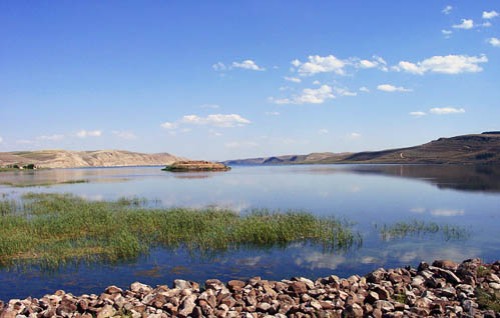 |
| territory of Gilead, Tribe of Gad, courtesy, Wikipedia |
During the Exodus from Egypt, the tribe was credited
with the raising of 40,000 men able to bear arms. Before
the Children of Israel crossed over the River Jordan to the Promised Land, the
tribe of Gad along with Reuben and half of Menashe insisted to Moses that they
settle on the east side of the river where the pastureland was good. Moses
agreed on the condition that they helped in the conquest of the land to which
they agreed. According to Numbers 32:33-36, Moses allocated to Gad the land in
the central region between Menashe on the north and Reuben on the south. “And
Moses gave unto them, even to the children of Gad, and to the children of
Reuben, and unto the half-tribe of Manasseh the son of Joseph, the kingdom of
Sihon king of the Amorites, and the kingdom of Og king of Bashan, the land,
according to the cities thereof with their borders, even the cities of the land
round about. And the children of
Gad built Dibon, and Ataroth, and Aroer; and Atroth-shophan, and Jazer, and Jogbehah; and Beth-nimrah, and Beth-haran; fortified cities, and folds for sheep.” Other cities
built, as described later on in the Book of Joshua were Bet Aram, Betonim, Mahanaim, Ramat Mitzpe, Succot, and Zaphon.
The tribal location
was never secure from invasion and attacks, since to the south and east it was
exposed to the Moabites, Ammonites,
Kedemites, Hagarites, and like the other tribes east of the Jordan, to Aram-Damascus and later the Assyrians. From the conquest of the
land by Joshua until the formation of the first Kingdom
of Israel in c. 1050 BCE, the Tribe of Gad was part of a
loose confederation of Israelite tribes. No central government existed, and in
times of crisis the people were led by ad hoc leaders known as Judges (see the Book of Judges). During the era of the Judges, the
submission of the people of Succoth and Penuel
to the Midianites and the Kedemites led them into a fratricidal war with Gideon
but the Gadites of Gilead,
the Gileadites, were saved from the Ammonites by Jephthah (Judg. 11). At this
time the Gileadites and the Benjamites entered into marital ties and a
fraternal alliance (Judg. 21). With the growth of the threat from Philistine
incursions, the Israelite tribes decided to form a strong centralized monarchy
to meet the challenge, and the Tribe of Gad joined the new kingdom with Saul as
the first king. After the death of Saul, all the tribes other than Judah remained loyal to the House
of Saul with his son Ish-boshet as king. Ish-boshet ascended the throne at
Mahanaim which was in Gadite territory. But after the death of Ish-boshet, the
Tribe of Gad joined the other northern Israelite tribes in making Judah's
king David the ruler of a re-united
Kingdom of Israel. David's wars with Aram, Ammon, and Moab greatly strengthened
the position of Israelite Transjordan and years later, Mahanaim became his base
in his war against Absalom (ii Sam. 17:24–27; 19:33). Mahanaim later became the
station of one of Solomon's 12 commissioners (i Kings 4:14). However, on the
accession of Solomon’s son Rehoboam, in c. 930 BCE
the northern tribes, including Gad, split from the House of David and from Saul's
tribe Benjamin to
re-form Israel as
the Northern Kingdom. When King Mesha of Moab rebelled against
Israel, he dealt harshly with the Gadites of Ataroth. The Gileadites suffered
greatly from the Arameans and the Ammonites during Israel's weakness in the
first half of the rule of the House of Jehu, but Gilead was reconquered by King
Jeroboam II during whose reign, there seems to have been a period of respite in
their history (ii Kings 14:28; cf. i Chron. 5:17). There are allusions to some
sort of ties between Gilead and the kingdom of Judah during the reign of Jotham
king of Judah, on the eve of the destruction of Gilead (i Chron. 5:17; ii
Chron. 27:5).
In 732 BCE, the territory
of Gad was laid waste by Tiglath Pileser III, king of Assyria, and most of its
inhabitants were exiled from their land (ii Kings 15:29), which was then
invaded by the Ammonites (Jer. 49:1). However, there are indications that a
remnant of the Gadites remained in southern Gilead, and it is possible that the
Tobiads known at the beginning of the Second Temple period derived from them.
The Gadite remnant and the Judean refugees in Ammon (Jer. 41) formed the
foundation of the Jewish community that developed in Transjordan in the days of
the Second Temple.
Officially though, the tribe of Gad was henceforth counted as one of the Ten Lost Tribes of Israel. However,
the Igbo Jews of Nigeria claim
descent from Gad as well as other Israelite tribes such as Ephraim, Naphtali, Menasseh, Levi, and
Zebulun.
But historians tend to dispute this theory. The Igbo on the other hand, remain
insistent and the debate continues to this day.
For a
subsequent history of the Israelite tribal territories east of the Jordan, see
posting on the Hashemite Kingdom of Jordan.
